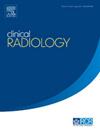模拟缩短肝脏磁共振成像结合对比增强计算机断层扫描对结直肠癌患者肝脏基线评估的临床表现
IF 2.1
3区 医学
Q2 RADIOLOGY, NUCLEAR MEDICINE & MEDICAL IMAGING
引用次数: 0
摘要
目的:评估模拟缩短gadoxetate肝脏磁共振成像(MRI)方案与对比增强计算机断层扫描(CE-CT)与标准gadoxetate MRI在基线时检测结直肠肝转移的诊断准确性和读者间一致性。材料与方法:每位患者由三名阅读者独立评估两组图像,记录转移灶和良性病变的数量和位置。第1组包括T1w、T2w、DWI、多相CE-T1w和肝胆期(HBP)图像(标准)。第2组包括T2w、HBP、DWI(来自第1组)和CE-CT(模拟缩写)。采用McNemar试验比较诊断性能。第一组和第二组的一致程度是由Cohen kappa确定的。为了在良性病变和转移的数量上达成一致,我们应用了类内相关系数(ICC)。结果:75例(转移245例,良性病变122例)。组1和组2的诊断准确率无显著差异(平均P = 0.74)。在阅读集1和阅读集2之间,转移瘤和良性病变的总数高度一致(κ = 0.81, 0.78)。在组1和组2中,读者之间的转移总数基本一致(ICC = 0.99, 0.99)。转移性节段受累的一致性很好(κ = 0.84-0.99)。结论:在基线时,模拟简化肝脏MRI与CE-CT结合使用与标准MRI方案非常吻合,用于肝转移检测。本文章由计算机程序翻译,如有差异,请以英文原文为准。
Clinical performance of a simulated abbreviated liver magnetic resonance imaging in combination with contrast-enhanced computed tomography for the baseline evaluation of the liver in patients with colorectal cancer
AIM
To assess the diagnostic accuracy and inter-reader agreement of a simulated abbreviated gadoxetate liver magnetic resonance imaging (MRI) protocol together with contrast-enhanced computed tomography (CE-CT) against a standard gadoxetate MRI for the detection of colorectal liver metastases at baseline.
MATERIALS AND METHODS
Three readers independently evaluated two sets of images per patient, recording number and location of metastases and benign lesions. Set 1 comprised T1w, T2w, DWI, multiphase CE-T1w, and hepatobiliary phase (HBP) images (standard). Set 2 included T2w, HBP, DWI (from Set 1) and CE-CT (simulated abbreviated). Diagnostic performance was compared using McNemar’s test. The level of agreement between sets 1 and 2 was determined with Cohen kappa. For agreement in the number of benign lesions and metastases, we applied intraclass correlation coefficient (ICC).
RESULTS
Seventy-five patients (245 metastases, 122 benign lesions) were evaluated. There was no significant difference in diagnostic accuracy between set 1 and 2 for each reader (mean P = 0.74). The total number of metastases and benign lesions showed high agreement between reading set 1 and 2 (κ = 0.81, 0.78). The total number of metastases showed substantial agreement between readers for set 1 and 2 (ICC = 0.99, 0.99). Good agreement was seen for metastatic segmental involvement (κ = 0.84–0.99).
CONCLUSION
At baseline, using a simulated abbreviated liver MRI together with CE-CT showed excellent agreement with standard MRI protocol for liver metastasis detection.
求助全文
通过发布文献求助,成功后即可免费获取论文全文。
去求助
来源期刊

Clinical radiology
医学-核医学
CiteScore
4.70
自引率
3.80%
发文量
528
审稿时长
76 days
期刊介绍:
Clinical Radiology is published by Elsevier on behalf of The Royal College of Radiologists. Clinical Radiology is an International Journal bringing you original research, editorials and review articles on all aspects of diagnostic imaging, including:
• Computed tomography
• Magnetic resonance imaging
• Ultrasonography
• Digital radiology
• Interventional radiology
• Radiography
• Nuclear medicine
Papers on radiological protection, quality assurance, audit in radiology and matters relating to radiological training and education are also included. In addition, each issue contains correspondence, book reviews and notices of forthcoming events.
 求助内容:
求助内容: 应助结果提醒方式:
应助结果提醒方式:


